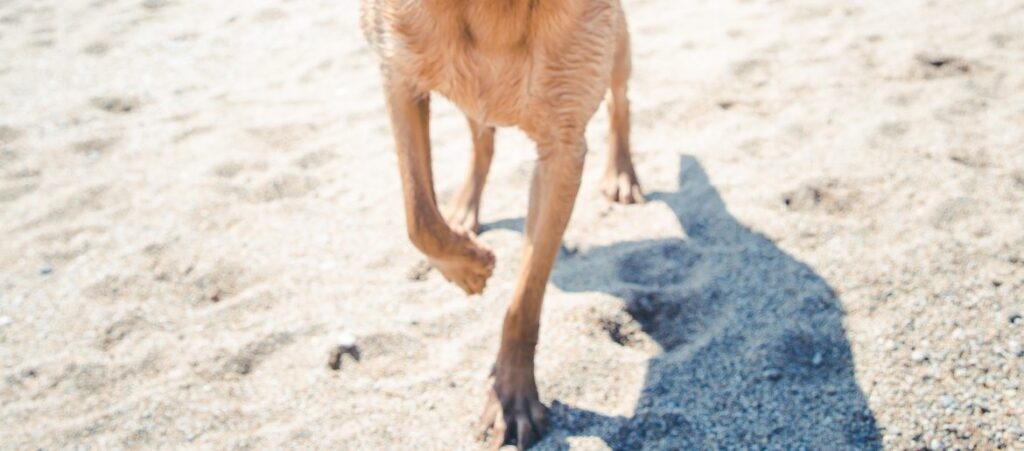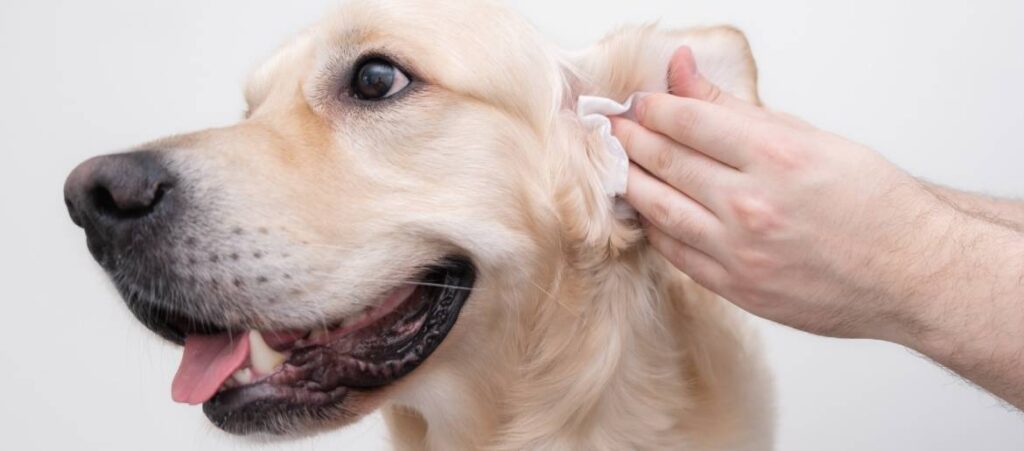Owing to the beautiful body structures and attributes of Golden Retriever can steal every heart that makes them the best family dog. But since owning a Golden Retriever includes a lot of responsibility, being a parent is not as easy as it seems. Generally, these dog breeds are susceptible to various health issues, and limping is one of them. But why is your Golden Retriever limping?
Generally, if your Golden Retriever is limping, there may be several reasons behind it. However, neurological disorders, valley fever, Lyme disease, arthritis, bone cancer, luxating patella, ligament rupture, and hip dysplasia are some of them. Along with this, injury, Panosteitis, osteodystrophy, osteochondritis, and elbow dysplasia also leads to limping.
Although limping of dog for few moments is natural, sometimes the case gets worse. And, that indicates fatal heal issues.
Moreover, the Golden Retrievers are the best family dogs. Therefore, they can be your perfect companion.
And you would want to do every possible thing to enhance and promote the lifespan of your Golden Retriever. But health issues like limping come as a hindrance.
Therefore, let us discuss limping.
What Is Limping?
Owing to the energetic and active attributes of the Golden Retrievers, they like running, playing, or roaming here and there. But limping or lameness is a peculiar behavioral change in the pet where he walks abnormally. And you may observe this abnormal walking in one or more limbs.
Furthermore, it indicates the illness of your dog. Thus, if your Golden Retriever starts limping, you should know he is in pain.
Is your Golden Retriever limping?
What do you do to resolve this peculiar behavior?
Your Golden Retriever Is Limping. Is It Serious?
Since Golden Retrievers are playful, they show limping for few moments. And then become fine. However, if your Golden Retriever is limping for several days and it becomes worse. Then, it may be a fatal issue or illness.
Do you know how to tell it is fatal or not?
Chronic Golden Retriever Limping
Sometimes, your Golden Retriever may be limping due to excessive training and playing. Thus, limping behavior of your pet resolves after resting in such a condition. However, if the behavior does not go away in two weeks, it is a fatal health issue that needs your concern.
Therefore, you must immediately consult with the Vet in such cases.
Acute Golden retriever Limping
Generally, acute limping occurs due to fractures, sprain, trauma, or injuries. Thus, in this case, your pet cannot put weight on one or more limbs. Since this type of limping is more serious, you need to take prompt actions.
However, based on the severity of acute limping are two types. Hence, they are:
- Severe Golden Retriever Limping- During this case, your pet refuses to put weight on his limbs. Instead, it taps the toe on the ground. Furthermore, if you force your Golden Retriever to ease its limbs, it starts showing aggressive behavior.
Severe cases result from bone fracture or breakage. Therefore, you should visit the Vet to diagnose the illness of your pet.
- Mild Golden Retriever Limping- In this case, your Golden Retriever starts limping and puts only a little weight in its limbs. Besides this, the pet looks healthy and happy. And it does not show aggressive behavior.
Though such a condition resolves after few days, your pet may whimper when you touch its limbs. Thus, you should make an appointment for the full-body checkup of your Golden Retriever.
What type of limping does your pet show?
What Are The Symptoms Of Severe Golden Retriever Limping?
Generally, your Golden Retriever is limping after extensive physical work. However, if it starts showing the following symptoms, it might be worrisome.:
- Behavioral change (hiding, aggression, fear, or inactiveness)
- Trembling
- Vocalization
- Bleeding
- Large swellings
- Lethargy
- Disorientation
- High fever and vomiting
Thus, since early prognosis leads to faster recovery, you should visit the nearby clinic as soon as possible when your pet shows such symptoms. So, you could prevent further progression of the disease.
But do you know what causes your Golden Retriever in limping?
Why Is Your Golden Retriever Limping?
Since younger puppies need more nutrition for growth or development, lack of adequate food causes limping in your Golden Retriever puppy. Besides this, too much diet also aggravates the problem. As too many calories or protein intake causes the imbalance of calcium and phosphorus, it hinders the growth of bones in the limbs.
Thus, Golden Retriever limping due to growth defect are:
- Osteochondritis Dissecans
- Pan osteitis
- Hypertrophic Osteodystrophy
Though limping in puppies may be due to growth defects, lameness in older Golden Retriever may be due to various other factors. Thus, the causes of your Golden Retriever limping based on the location of limbs it affects are different.
Hence, the reasons for your Golden Retriever limping in the rear legs are:
- Kneecap Dislocation
- Hip dysplasia
- Ligament rupture
Furthermore, the cause of your Golden Retriever limping of front limbs are:
- Muscles and tendon injuries
- Elbow dysplasia
Moreover, many diseases induce your Golden Retriever to limp. And they are:
- Valley fever
- Neurological disorders
- Lyme disease
- Arthritis
- Bone cancer
Now, let us know in brief about all the causes:
Injury or Trauma Leads To Golden Retriever Limping
As the Golden Retrievers are active dog breeds, they are continuously exploring new places. Thus, while they run, they may get injuries. So, your Golden Retriever might be limping due to such injuries.
However, your pet may recover from these traumas within few days without assistance. But if the lameness lasts longer than a week, it indicates fatal health issues that need professional guidance.
In addition, most of these injuries are:
- Carpal hyperextension syndrome
- Sprains
- Fractures
- Strained tendons
Golden Retriever Might Be Limping Due To Panosteitis
Generally, Panosteitis is a bone inflammation in the six to nine-month-old puppies of larger dog breeds. Moreover, the bone marrow develops abnormally during this disease, your pet experiences growing pain.
Even though your pet may put weight on his limbs, it shows signs of pain while moving. Furthermore, inactivity, shifting of body weight from one leg to another, and trembling are the signs of Panosteitis.
Hypertrophic Osteodystrophy Leads To Golden Retriever Limping
Hypertrophic osteodystrophy (HOD) is the inflammation of the cartilage at the end of growing bones. Moreover, the irreversible condition occurs in the two to six months old puppies. And you can only manage the conditions.
Therefore, you must be cautious about diet and exercise while breeding puppies. Further, the symptoms that the pet may show in this disease condition are:
- Fever
- Hot and swollen joints
- Lethargy
- Loss in weight
- Immobility
Osteochondritis
Since osteochondritis is a defect in the cartilage surface of the joints, it causes the floating of cartilage around the joints area. As a result, your pet experiences immense pain during movement. Moreover, the health condition also affects other parts of the limb like the elbow, knee, etc.
The symptoms vary according to the severity of individual pets. However, the most common symptoms are changes in the behavior of your pet and immobility. Furthermore, the only treatment of this health condition is surgical replacement of defective cartilage.
Elbow Dysplasia
Elbow dysplasia is a sudden or gradual disorder that affects the front legs of your pet. Furthermore, this dysplasia involves series of developmental defect that causes malformation and degeneration of the elbow joint. As a result, your Golden Retriever starts limping.
However, the most common sign of this health condition is vocalization when you touch their elbow. Thus, physical examination and X-ray can ease your doubt if your pet starts showing symptoms of elbow dysplasia.
Hip Dysplasia
Hip dysplasia is an abnormality of the hip joint that affects the rear legs of your pet. Generally, this is a genetic disorder of large dog breeds that deteriorates the structure of the ball and socket hip joint.
As a result, your pet feels difficulty in moving. So, your Golden Retriever starts limping.
Moreover, the sudden and gradual symptoms of this defect include:
- Difficulty in walking and jumping
- Lose of interest in playing
- Abnormalities of gait
- Difficulty in lying down or standing
If your pet shows these symptoms, seek the help of the Veterinarian immediately.
Golden Retriever May Be Limping Due To Rupture Of Ligament
Like humans, ligament rupture occurs when the pet accidentally twists his hind limb. Since this incident causes the tearing of the cruciate ligament, the condition is a ruptured anterior cruciate ligament. When your enthusiastic pet jumps around the car or slippery, it is more likely to tear the ligament.
Further, ligament rupture is common in larger breeds. Since the ligament rupture causes swollen knees, your Golden Retriever starts limping.
Kneecap Dislocation
Generally, kneecap dislocation (luxating patella) affects the rare legs of your pet. Thus, your Golden Retriever may experience pain in the knee cap area. Furthermore, the prominent signs of the dislocated kneecap are:
- Lameness
- Skipping or hopping
- Putting weight only in the hind leg while walking
- Slow walking
Bone Cancer
As the Golden Retrievers are susceptible to several diseases, cancer is the most common one. Moreover, bone cancer is a fatal health issue and needs immediate treatment. Therefore, you must consult with the professionals as soon as possible when your pet shows the following symptoms:
- Severe lameness for weeks
- Unreasonable fractures
- Tumors
- Lethargy
- Loss of appetite
- Aggressive behavior
Arthritis Leads To Golden Retriever Limping
Like humans, older dogs are also prone to functional loss and disability. Thus, when dogs get older continuous friction between joints leads to inflammation and arthritis. However, the most common signs of arthritis in your Golden Retriever are:
- Vocalization in the morning
- Slow walking
- Weight gain
- Lethargy
- Sleepy
- Alertness
- Loss of interest in its favorite activities
Furthermore, you can use anti-inflammatory medication to manage this condition under the guidance of your professionals. Besides this, a healthy lifestyle also eliminates chances of arthritis in your Golden Retriever.
Lyme Disease
Generally, ticks cause Lyme disease that does not show early signs until it progresses, to the point where your pet becomes unable to move. However, it takes few months after the tick exposure to develop the disease and show symptoms.
Furthermore, the prominent symptoms of Lyme disease are:
- Loss of weight
- Joint pain
- Inflammation of lymph nodes
- Fever and lethargy
Since antibiotics like cephalexin or doxycycline help elicit this disease, you can use those medications. But use it under the prescription of professionals.
Valley fever
Valley fever is a fungal infection that affects either too young or too old Golden Retrievers. And the most common symptoms of this disease are:
- Fever
- Harsh cough
- Depression
- Lethargy
- Lameness
Along with this, your Golden Retriever also shows limping. However, you can use fungal medication for several months to treat this disease.
Golden Retriever Starts Limping In Neurological Disorders
The neurological disorders put pressure on the nerves of the spinal cord in the brain. Thus, your pet loses coordination between the messages from the brain to the limbs. Eventually, it causes improper movement of your pet.
As a result, your Golden Retriever starts limping. Moreover, there are no specific signs of neurological disorders. Therefore, you must seek the help of a Veterinarian to diagnose and treat this disorder.
Now, after you are familiar with the cause of your Golden Retriever limping, let us dig into the proper treatment for the limping behavior.
What To Do If Your Golden Retriever Is Limping?
Management of limping in your Golden Retriever depends on the cause of limping. Although you should seek professional advice for treatment, you may not get the help of a professional everywhere you go. Moreover, you cannot see your pet suffering until you get an appointment with the Veterinarian.
So, in this case, you can follow the following ideas:
Limb inspection
When your Golden Retriever suddenly starts limping, it may be due to injuries. Thus, observe the limb and toes of your pet. And look for the following signs:
- Torn toenails
- Inflammation in legs or paw
- Insect bites
- Splinters or cuts in the paw
- Stuck foreign particles between the toe
Do you see this evidence?
If you find something stuck in the paws, use tweezers to remove it. Furthermore, you can use a mixture of Epsom salts and water to remove the deeper particles from the toes.
Examine the limb
However, if you manifest swollen or redness in the limb of your pet, you can follow the following tips to ease the pain of your pet:
- Observe the limbs
- Gently lift the fractured limb you suspect
- See the behavioral change of your pet (whimpering, growling, dilation of pupils, etc.)
- Use a soft cotton cloth to wrap the area to support
- Analyze the position where your pet feels comfortable and settle the pet.
But if your pet is aggressive, you must be cautious while touching the affected area.
Consult With The Vet
Though limping behaviors due to cut or foreign particles are manageable, lameness due to health issues (like cancer, dysplasia, fracture, etc.) needs the Veterinarian. Therefore, visit the Veterinarian for a diagnosis, treatment, and management of the health issue.
Furthermore, the Veterinarian also gives helpful suggestions for the Golden Retriever care that leads to a healthier life for your Golden Retriever.
Weight Management
Since Golden Retrievers love food, they are prone to obesity. As a result, they are susceptible to several diseases that affect the development of bones and joints. Therefore, your Golden Retriever begins limping due to excessive weight.
Thus, follow the following ideas to manage the weight:
- Make a feeding schedule with all essential nutrients
- Give the pet adequate training to balance the calories intake and burnt
- Include omega-rich foods in the diet of your Golden Retriever
- Give healthy natural snacks as treats
- Avoid giving human foods like chocolate, mushroom, sodas, coffee, etc.
- Balance the diet of your pet according to its age.
Furthermore, proper grooming your pet can eliminate other possible health issues like constipation, ear infections, eating disorders, etc.
Is your pet limping? What do you think is the cause?
Have you consulted with your Veterinarian for treatment?
What Are The Treatments For Golden Retriever Limping?
Generally, their treatment of the limping depends on the cause and severity of the case. And the Veterinarian may prescribe various types of medication after the diagnosis of your pet. However, some of the treatment options are:
Treatment For Mild Golden Retriever Limping
Since mild limping resolves after rest, the Veterinarian prescribes NSAIDS to accelerate the recovery. Although these medications are for humans, they are helpful for your pet too. Hence, they are:
- Meloxicam
- Etodolac
- Deracoxib
- Carprofen
Treatment For Golden Retriever Limping Due To Joint Defect
Since the join defect limping causes due to lack of nutrition in the puppy, the Veterinarian recommends nutritional supplements in this case. And those supplements are:
- Avocado soybean unsaponifiable
- Methylsulfonylmethane
- Omega-3 fatty acids
- Chondroitin sulfate
- Glucosamine
Other Treatments For Golden Retriever Limping
Generally, depending on the condition and severity, the Veterinarian recommends several other treatments. And they include:
- Bandages, casts, braces, etc.
- Surgery
- Chemotherapy or radiotherapy in bone cancer
- Weight management
- Therapeutic ultrasound
- Cold laser treatments
- Physical therapy and Acupuncture
- Neuromuscular electrical stimulations
- Assistive devices (wheelchairs, slings, harnesses, or prosthetic limbs)
However, discuss the best therapy for your pet with the Veterinarian to promote the healthy lifespan of your pet.
What do you think? Are these ideas helpful for your pet?
Do you know more tips to manage to limp?
If you do, please share your ideas in the comment section.





